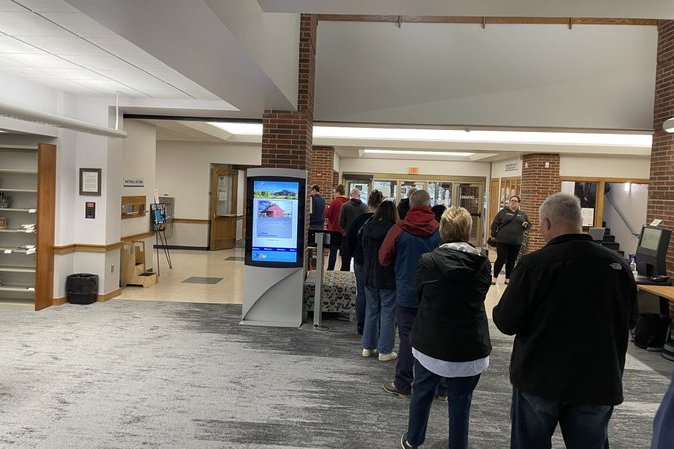The Iowa Secretary of State’s office has released the final unofficial absentee ballot totals for the 2022 general election. These figures reflect all in-person early voting, which wrapped up on November 7, as well as all ballots that arrived in the mail or through drop boxes at the close of business on November 7. A later report will include all absentee ballots that arrive at county auditors’ offices by 8:00 pm today.
Some quick thoughts on what we know about this year’s numbers:
Overall, Iowa’s early vote was way down this year, compared to the last two midterm elections.
Bleeding Heartland has published daily tables showing absentee ballots requested and returned, statewide and in each Congressional district. You can find those archived here.
The numbers for absentee ballots county auditors had received by November 8, 2022:
| Congressional district | Democrats | Republicans | no-party | other | total |
|---|---|---|---|---|---|
| IA-01 | 55,446 | 30,549 | 17,165 | 279 | 103,439 |
| IA-02 | 49,379 | 30,405 | 16,950 | 254 | 96,988 |
| IA-03 | 49,467 | 26,540 | 13,731 | 252 | 89,990 |
| IA-04 | 31,778 | 34,223 | 11,429 | 214 | 77,654 |
| statewide | 186,070 | 121,717 | 59,275 | 999 | 368,071 |
On election day 2018, county auditors had received a total of 538,043 ballots. Going into the 2014 midterm, county auditors had received 472,374 ballots.
Why the decline? The most important factor may be the shortened early vote window. Iowans were able to start voting 40 days before the 2014 election and 29 days before the 2018 election, but just 20 days before this year’s election.
It’s also possible that fewer Iowans feel inspired to participate in this election compared to four years ago.
A side cautionary note: If you click through to view the tables as of election day in 2018 or 2014, remember that Iowa’s U.S. House map changed following the 2020 census, as did the district numbering. The four Congressional districts were configured differently, and most of what we now call IA-01 was part of IA-02 in 2018. By the same token, most of what we now call IA-02 was called IA-01 on any tables from the last decade.
Iowa Democrats are closer to their previous years’ benchmarks.
Democrats had a lead of about 64,000 banked votes going into this year’s election. Their lead in ballots returned was only about 9,000 as of election day 2014 and about 40,000 in 2018.
Iowa absentee ballot numbers statewide, as released by the Secretary of State’s office on election day
| Year | Democratic requests | Democratic returns | Republican requests | Republican returns | no-party requests | no-party returns |
| 2014 | 216,889 | 189,992 | 194,065 | 180,847 | 118,574 | 100,802 |
| 2018 | 248,398 | 230,294 | 199,646 | 189,961 | 125,222 | 114,878 |
| 2022 | 194,127 | 186,070 | 124,587 | 121,717 | 61,673 | 59,275 |
The 186,070 ballots received by registered Democrats as of yesterday amounts to 80.8 percent of the 230,294 ballots county auditors had received from Democrats going into election day 2018.
In contrast, Iowa Republicans have returned only about 64 percent as many absentee ballots as four years ago.
The drop-off was even greater for no-party voters, who have returned about 47 percent as many absentee ballots as they had going into election day 2018.
But before Democrats get too excited, remember:
Absentee ballots may comprise a lower share of this year’s overall vote.
The drop in early voting could point to lower turnout overall, but it’s also possible that many Iowans adjusted their behavior and decided to vote on election day this year. Anecdotally, many Democrats have said they planned to vote on November 8 to avoid the risk of a mailed ballot not arriving in time.
By the same token, Republicans may have been influenced by former President Donald Trump and other conservative influencers, who denigrate the idea of early voting.
If turnout today comes close to matching the 1,334,279 Iowa had in 2018 (which was quite high), then about three-quarters of all votes will be cast on November 8.
On the other hand, if turnout is down to the 2014 level of 1,142,311 Iowans participating, then only about two-thirds of all votes cast will come on November 8. In that case, there would be a better chance of Democratic early vote leads withstanding the typically higher Republican participation on election day.
We’ll know more after the official canvass, and especially once the Secretary of State’s office releases its statewide statistical report on this year’s election, which will probably happen in January.
Top photo: Voters wait to cast ballots at a satellite voting location in West Des Moines on November 5. Originally posted on State Senator Claire Celsi’s Twitter feed.

